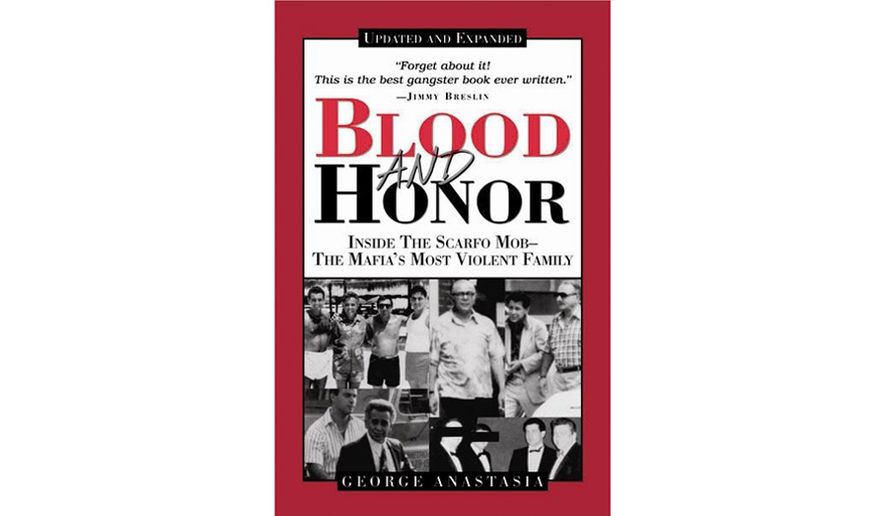OPINION:
In a previous column, I wrote about Frank Sheeran, the late Philadelphia criminal who was portrayed by Robert De Niro in Martin Scorsese’s Netflix film, “The Irishman.” Although I don’t subscribe to Sheeran’s claim that he murdered Jimmy Hoffa and his other boasts, I liked the film.
I especially liked the film as it featured organized crime figures from South Philadelphia, where I grew up. Readers have contacted me and asked how to learn more about the South Philly-South Jersey Cosa Nostra crime family. I responded by suggesting that they read George Anastasia’s true crime books, “Blood and Honor,” “The Goodfella Tapes” and “The Last Gangster.”
Jimmy Breslin said George Anastasia’s “Blood and Honor: The Scarfo Mob, the Mafia’s Most Violent Family” was the best gangster book ever written. Mr. Anastasia, a former Philadelphia Inquirer reporter, covered the rise and fall of the Nicodemo “Nicky” Scarfo Philadelphia Cosa Nostra crime family in the 1980s.
With Mr. Anastasia’s knowledge from years of covering the mob and his interviews with Nick Caramandi, a Scarfo mob soldier turned government witness, “Blood and Honor” offers the backstory of the murder of South Philly-South Jersey mob boss Angelo Bruno (portrayed by Harvey Keitel in “The Irishman”) and the eventual rise of Scarfo. The book details the schemes, the internecine mob war and the many murders ordered by Scarfo.
I interviewed Philip “Crazy Phil” Leonetti, Scarfo’s nephew and underboss who became a government witness. He described his uncle as smart, devious, calculating and psychopathic. He said his uncle enjoyed committing murders.
“He couldn’t handle the job. He talked about everybody else going power-crazy, but he went power-crazy,” Leonetti told me. “He wanted to kill everybody.”
Another fine book on the South Philly mob by George Anastasia is “The Goodfella Tapes: The True Story of How the FBI Recorded a Mob War and Brought Down a Mafia Don.”
The book covers how the FBI secretly recorded John Stanfa, the mob boss who took over after Scarfo went to prison. Stanfa, a Sicilian-born criminal, was engaged in an internecine mob war from 1993 to 1995. As Mr. Anastasia explains, one side was old world Sicilian and the other side was born and bred South Philadelphians, the sons and nephews of the previous mob leadership.
Stanfa believed it was safe to talk shop and plot murders in his lawyer’s office. But the FBI convinced a judge that the lawyer was involved with crimes, so the FBI was allowed to bug the office. The FBI recorded 2,000 conversations, which is the basis of “The Goodfella Tapes.”
“Goodfellas don’t sue goodfellas,” one mob philosopher advised a mob associate and potential litigant as the FBI listened in. “Goodfellas kill goodfellas.” The book offers a good number of other insightful comments as well.
Like “Blood and Honor,” South Philly is featured so prominently in “The Goodfella Tapes” that it’s practically a character.
“The Philadelphia mob is probably the most dysfunctional crime family in America,” Mr. Anastasia said. “It’s the Simpsons of the underworld.”
A third George Anastasia book I’d recommend is “The Last Gangster: From Cop to Wiseguy To FBI Informant: Big Ron Previte and the Fall of the American Mob.”
Ron Previte, a 300-pound, 6-foot mobster called “the Fat Rat” by the South Philly wiseguys, was a former crooked cop, thief, gambler and Cosa Nostra capo. In “The Last Gangster,” Previte told Mr. Anastasia that he saw the mob fading, so like any good gambler, he hedged his bet by becoming an FBI informant.
He wore a wire from 1997 to 1999 and his recordings sent the then-mob boss Ralph Natale and underboss Joey Merlino to prison. Natale later cooperated with the feds, becoming the first mob boss to do so.
With Mr. Anastasia’s interviews with Ron Previte and his research through a mountain of law enforcement records and court files, “The Last Gangster” is an interesting and gripping book that reads like crime fiction.
George Anastasia, the grandson of Sicilian immigrants, was born in South Philly and raised in South Jersey. As a reporter, he said he was fascinated by the dark side of the Italian American experience.
As I’m half-Italian on my mother’s side, I asked George Anastasia how he responded to the criticism I’ve heard from Italian-Americans in South Philly. They believe his extensive coverage of Cosa Nostra promoted a negative image of Italian-Americans, the vast majority of whom, I might add, are not criminals.
“These guys are taking the positive values of the Italian American experience; honor, family and loyalty, and bastardizing them for their own end,” Mr. Anastasia replied. “I think you should shine a light on that.”
He also said that he took great pride in the positive contributions that Italians have made to this country and to the world.
• Paul Davis’ On Crime column covers true crime, crime fiction, mysteries and thrillers.




Please read our comment policy before commenting.